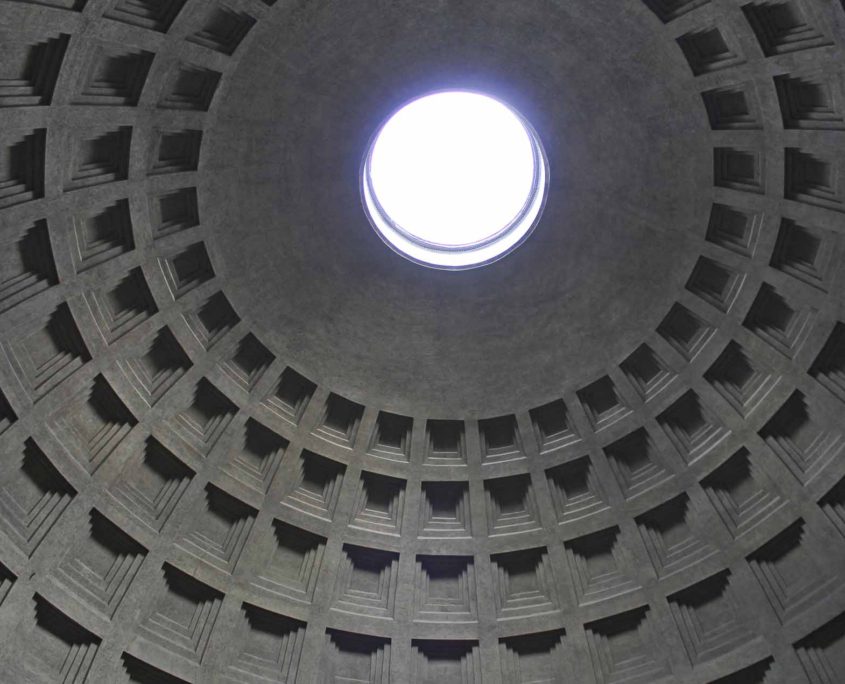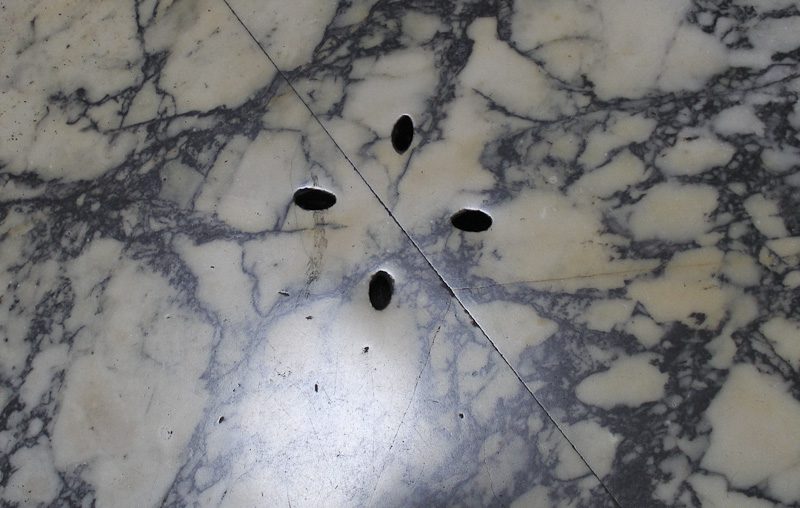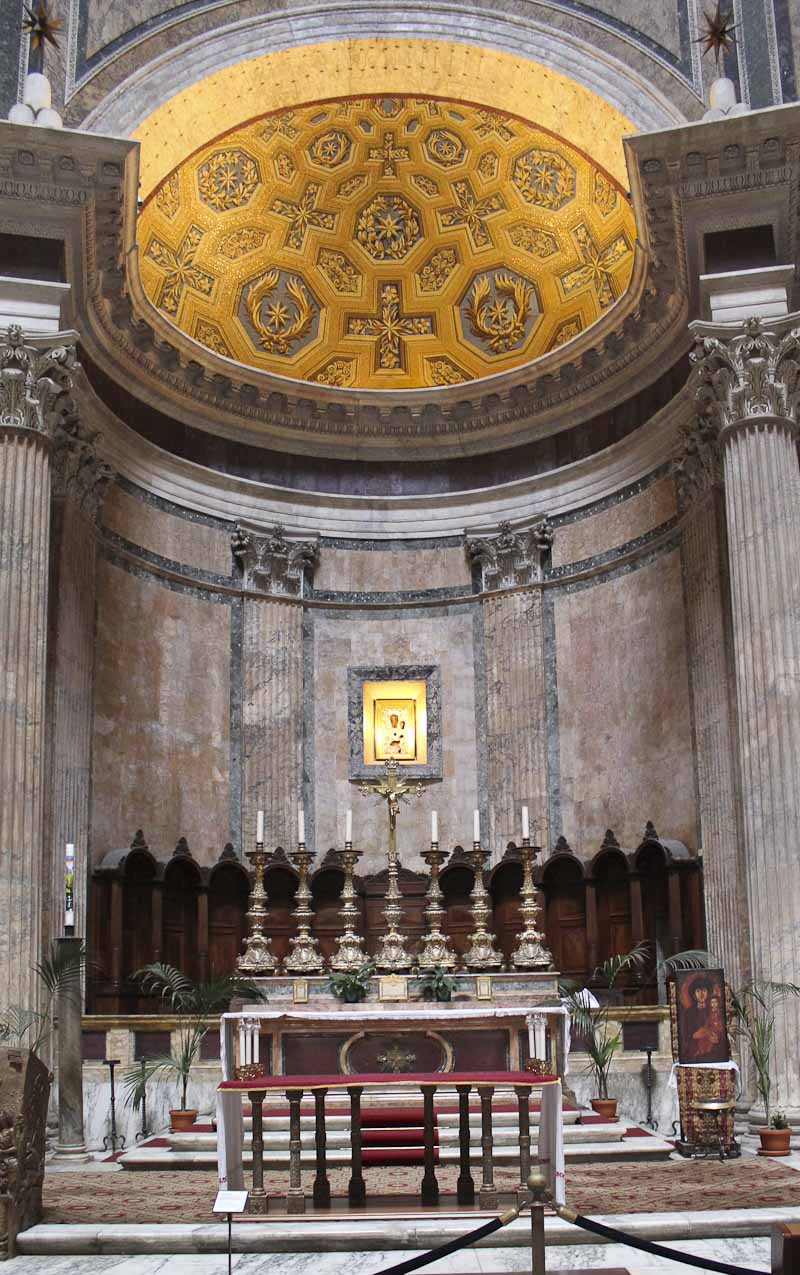Facts About the Pantheon in Rome
The Pantheon on Piazza della Rotonda is one of the main sights of Rome and the best preserved building from antiquity.
With more than 7 million visitors a year the Pantheon is one of the most popular heritage sites in Italy. And people are still amazed by the breathtaking proportions and the engineering skills mastered during the Roman Empire 2000 years ago. No wonder Michelangelo has been quoted for saying that the Pantheon looks more like the work of angels, not humans.
The enigmatic building has been described in hundreds of books, articles, travelogues and lists from which I have accumulated this collection of what I believe are facts about the Pantheon.
Origin
1. The Pantheon was built on a site that had previously accommodated temples.
2. The name Pantheon is derived from Greek “pan” meaning “all” and “theon” meaning “gods”, which can be interpreted as all-worship or all-gods. Some interpret this as a building dedicated to the worship of all pagan gods, although the gods of the Roman world normally had their own temples.
3. The first Pantheon was primarily a wooden structure erected between 27-25 BC. It was built by order of Marcus Agrippa, a Roman Consul under the first Emperor, Caesar Augustus. That building would not be recognizable today.
4. It stood within a complex that also included the Baths, the Septa Julia, a temple of Neptune and the portico of the Argonauts.
5. The temple of Neptune was connected to the back of the Pantheon, and you can still see some dolphins in the marble friezes if you go behind the monument.
6. The first wooden Pantheon burnt down about 100 years later in 80 AD.
7. It was rebuilt by Emperor Domitian, but was struck by lightning and burned again in 110 AD.
Hadrian’s Pantheon
8. Pantheon as we know it was built in 120 AD by Trajan and his successor Hadrian, who was passionate about architecture.
9. Trajan had a close collaboration with the famous Greek architect and engineer called Apollodorus of Damascus, who helped to design the dome, before an argument between Hadrian and Apollodorus led to Apollodorus’ banishment and death.
10. Hadrian made some changes to the original building. He reconstructed the portico, enlarged the circular structure of the hall and placed the entrance to the north, instead of to the south like the first Pantheon.
11. He also constructed a pronaos with sixteen columns in pink and gray granite from Egypt.
12. Pantheon was built like an observatory with the meridian and sunlight factor in mind.
13. Along the perimeter there are 7 niches perhaps attributed to the seven deities from the cult of planets, that is Mercury, Venus, the moon, the sun, Mars, Jupiter and Saturn.

The Latin inscription above the entrance says “built by Marco Agrippa, son of Lucio, consul for the third time”.
The Inscription
14. Through time the Pantheon has kept the name of Agrippa on the front of the pronal.
15. The Latin inscription at the entrance reads: “M.AGRIPPA.L.F.COS.TERTIUM.FECIT”. It translates roughly as “built by Marco Agrippa, son of Lucio, consul for the third time”.
16. Hidden above one of the capitals of the columns that form the pronaos a very small Barberina’s bee is engraved in the stone. It is a symbol of Pope Urban VIII Barberini who had wanted the reconstruction of the column.
Construction
17. Considering that the Pantheon was constructed 2000 years ago it is an engineering masterpiece.
18. The building is formed as a cylinder made from stone, brick and a kind of concrete. It is covered by one of the largest domes in the world.
19. The height from the floor to the oculus, and the diameter of the dome are exactly the same 43 m. This means that a perfect sphere could fit inside the Pantheon.
20. The walls of the Pantheon are 6 m thick in order to withstand the pressure of the dome which is extended outwards.
Dome
21. The immense half sphere of the dome was originally covered in gilded bronze. Now it is covered in lead.
22. The gilded bronze tiles were looted by the Byzantine emperor Constans II in 663 who took them to Syracuse in order to ship them to Constantinople.
23. The dome is made entirely out of concrete with 5 rows of 28 sunken panels or coffers that diminish in size as you get closer to the oculus. Studies of the construction show that lighter materials were used the closer you get to the oculus. This allowed the building to sustain the pressure load.
24. The construction of the dome is a mystery. Some believe a complex scaffolding was used to lay the concrete, while others believe the entire building was filled with sand from Ostia during construction.

The oculus of the Pantheon surrounded by the coffers of the dome.
Oculus
25. The opening in the centre of the dome is called oculus in Latin which means eye.
26. Rain and other elements can enter the building through the oculus, when doors are closed.
27. As an ancient Roman tradition, red rose petals rain through the oculus after the pentecostal mass in order to mark the descent of the holy spirit. The petals are poured through the oculus by a fire brigade. For the first Christians the rose represented the holy spirit and the blood shed by Jesus Christ.
28. There is a bronze ring on the interior of the oculus as a decorative element.
29. The oculus was originally the only source of light in the building.
30. The oculus has a diameter of approximately 9 m, and when the sunlight enters the building it marks specific points on the walls. That way you can use the light to tell the season and the time of day. The pattern repeats itself annually.
31. The oculus is like a tromp l’oeil on the nights when you can see the moon through the roof.
A Spectacle of Light
32. The light that penetrates the oculus both day and night creates a chiaro scuro spectacle, where the effects of light and shadow are eternally at play.
33. On April 21 which is the founding day of Rome at 12 o’clock the golden light that enters the dome through the oculus falls precisely on the door and those who enter. The effect was exploited to make the emperor appear like a worshipped god.
34. On winter solstice the sun lights up the upper part of the dome, while on other equinoxes the rays create brilliant reflexes on the cornices.
35. Maximum light enters the building at summer solstice at 12 o’clock, when the sun covers the oculus completely and raises a vertical column of light from an enormous disc of light on the floor.
The Entrance
36. The bronze doors are 7 metres high, and it requires the strength of 3 people to close them.
37. The doors are not original, but were supposedly fitted in the 15th century.
38. The principal entrance is marked by sixteen Corinthian columns surmounted by a frontone typical of Greek Temples
39. The columns are one solid piece of stone. They are 12 m high, 1,5 m in diameter and estimated to weigh 60 tons each.
40. The columns were transported from Egypt by ship and then dragged on wooded rollers to the building site. Elephants were probably used to raise them up.

Drains placed around a converse part of the floor prevent rain entering the Pantheon through the oculus from forming a poodle.
The Floor
41. The floor is richly decorated with polychrome marble.
42. Some sections of the floor and the columns of two chapels are covered in imperial purple porphyry, a highly prized stone material from the only existing quarry in Egypt. The quarry is now exhausted, and the value of the stone exceeds that of gold.
43. The floor of the Pantheon does not get wet when it rains. 22 drains placed around a converse part of the floor prevent the drops from forming a poodle.
Legends
44. According to Roman legend the first temple on Campo Marzio was dedicated to Romulus, the mythical founder of Rome, and placed on the spot where he died and ascended to heaven.
45. Another legend maintains that the dead body of Romulus was grabbed by an eagle inside the Pantheon and taken to heaven to be among the gods.
46. Popular belief has it that the oculus in the dome was once covered by a large bronze pine cone left there by the devil. The evil spirits fled taking the cone with them, when the Pantheon was consecrated by pope Bonifacio. The bronze pine cone is now placed in the courtyard della Pigna in the Vatican.
47. It follows that the fleeing devil created a hole in the dome which is now the oculus.
48. Another mediaeval legend has it that the moat surrounding the Pantheon was created by the angry devil, who ran around the temple, where a magician, called Pietro Bailardo, had taken refuge after selling the devil his soul..
49. It was believed that rain was unable to fall inside the pantheon, because the heat of lighted candles transformed it into condensation.
50. The Pantheon has been haunted by several ghosts. Before the Pantheon was consecrated into a church, Christians complained about being plagued by pagan ghosts that haunted the building.
51. As late as the 1930s a carabinieri on guard encountered the spectre of King Umberto I on the square in front.
The Numbers
52. Inside the pantheon there are certain numbers with specific symbolic values.
53. It is possible to divide the circumference into 16 in keeping with etruscan traditions and to identify the four directions of Roman city planning in accordance with the cardo and the decumanus.
54. There were seven niches along the perimeter of the building, and seven is a number often repeated in astronomy. For instance, there are also seven stars in the big dipper that circles the northern sky.
55. The dome has twenty-eight coffers for each superimposed circumference. The number 28 is associated with the lunar cycle of 28 days.
56. Twenty-eight is also a perfect number which is obtained as the sum of its divisors: 28 = 1 + 2 + 4 + 7 + 14 but it is also equal to the sum of the first 7 integers 28 = 1 + 2 + 3 + 4 + 5 + 6 +7.

A porphyry basin beneath the high altar contains the relics of Christian martyrs who had died in the catacombs.
Consecration
57. With the advent of Christianity the Pantheon was closed, abandoned and was sacked by the barbarians.
58. In 608 AD the Pantheon was donated by the Byzantine emperor Phocas to pope Bonifacio IV, who converted it to a church called “Santa Maria ad Martyres” on May 13th 609 AD.
59. The church was dedicated to all the early Christians who were persecuted by the Romans and died in the catacombs.
60. Twenty-eight cartloads of holy relics of martyrs were said to have been removed from the catacombs and placed in a porphyry basin beneath the high altar.
61. It is believed that the consecration as a church helped the Pantheon to survive barbarian raids.
62. Pantheon is still a Catholic Church that regularly performs religious rites and ceremonies
Sepulture
63. The Pantheon is also a place of sepulture.
64. Raphael Sanzio, who died in 1520, is buried in the Pantheon. His tomb sits in the back left-hand side of the structure under a statue of Mary holding baby Jesus which was done by an artist named Lorenzetto.
65. His tomb reads ILLE HIC EST RAFFAEL, TIMUIT QUO SOSPITE VINCI, RERUM MAGNA PARENS ET MORIENTE MORI, which Alexander Pope translated to, “Living, great nature feared he might outvie Her works; and, dying, fears herself may die.”
66. Raphael is buried next to his fiancee, Maria Bibbiena. Gossip has it that he always intended to marry her but postponed the day repeatedly because he was madly in love with Margherita Lute who was a baker’s daughter and the subject of many of his works of art including La Fornarina, which now hangs in Palazzo Barberini.
67. Numerous other painters – Annibale Caracci, Taddeo Zuccari, Baldassarre Peruzzi, Pierino del Vaga and Giovanni da Udine – are also buried in the Pantheon.
68. In 1870, the new government of the united Italy took over the maintenance of the building, and Pantheon became a shrine and memorial to the kings of Italy. It houses the remains of Vittorio Emanuele II, Umberto I and Margherita di Savoia.
69. Victor Emmanuel II died in 1878 and his tomb reads ‘Padre della Patria’ which translates to the Father of the Fatherland. The fact that he was allowed to be buried here is a mystery. Pope Pius IX refused to meet with Emmanuel after he overtook Rome and never acknowledged his reign.

The Pantheon and its surrounding have changed over the last 2000 years, but the main structure is still intact.
Reconstructions
70. In 1652 Urban VIII Barberini ordered the removal of all the bronze coatings of the portico beams to use them for the 80 cannons of Castel Sant’Angelo and for the four twisted columns of the famous canopy by Gian Lorenzo Bernini in St. Peter’s Basilica. This lead to the popular Roman saying “what the barbarians did not destroy, Barberini destroyed”.
71. Barberini also added two bell towers, sometimes attributed to Bernini, to the outside of the Pantheon. The towers never fitted with the design of the original building and they were taken down in the mid 1880s, since their nicknames became ass’s ears.
Records
72. The Pantheon’s had the largest dome in the world for over 1300 years, until it was surpassed by Florence’s cathedral in 1436. Today the world record is held by the National Stadium in Singapore, while the Pantheon remains in the top 20.
73. The dome of the Pantheon is the world’s largest concrete dome suspended without reinforcement. This is possibly due to a combination of factors, including the arches contained in the 6m-thick walls supporting the ceiling, the various densities of concrete used in the construction of the dome and its thickness which lessens gradually as it nears the centre. This is why the dome appears slightly flattened from the outside while seeming perfectly round from the inside.
Opening hours
The Pantheon is located at Piazza della Rotonda in Rome’s historic centre.
Mon-Sat 09.00-19.30, Sun 09.00-18.00. Last admissions are 15 minutes before closing time.
There is free entry to the Pantheon, but visitors are asked to respect the church dress code, ie. no shorts or bare shoulders.


 Italian Notes
Italian Notes Italian Notes
Italian Notes
Leave a Reply
Want to join the discussion?Feel free to contribute!